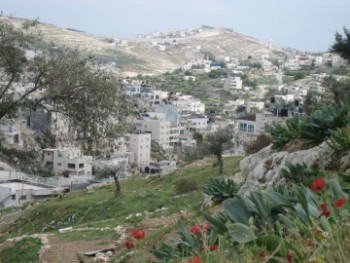
| • | Synagogues - A comprehensive listing of Jerusalem Synagogues, Jerusalem Shuls and Jerusalem Jewish Temples. |
| • | Churches - Complete guide to the Churches in Jerusalem, including photos. |
| • | Mosques - A complet list of Mosques |
| • | Yeshivas - A list of Yeshivas in Jerusalem |


Travel Partners
Advertisment: Judaica Gifts | Book your hotel in Jerusalem > Jerusalem Neighborhoods > Silwan Jerusalem
Navigation
Silwan from Abu Tor - Photo Credit: Rebecca Manski
Silwan Jerusalem
Silwan Neighborhood Jerusalem - Silwan neighborhood is located southeast of the southeastern corner of the Old City wall in Jerusalem
Silwan, or Kfar Shiloah, is a mostly Arab neighborhood of roughly 45,000, adjacent to the Old City of Jerusalem, extending along the Kidron Valley and running alongside the eastern slopes of Jabal al-Mukaber. Etymology: Siloam is an ancient Greek name derived from the more ancient Hebrew: Shiloah, the Arabic: Silwan, was in turn derived from the Greek, Siloam.
Historically, Silwan was located on the eastern slope of the Kidron Valley, near the outlet of the Gihon Spring at the Pool of Siloam, opposite the City of David. The villagers took advantage of the arable land to grow vegetables for market in Jerusalem.[1] Nineteenth century travelers describe it as verdant and cultivated,[2][3] and perched on a steep, slippery scarp cut into hillside

The Illustrated Torah - Chumash (Five Books of Moses)
Fully illustrated, colorful and attractive, and includes the weekly Torah portions and the Haftarot readings (weekly readings from the Writings and the Prophets).
Inside the Book
God said, "Let there be light"; and there was light.
Inside the Book
God said, "Let there be light"; and there was light.

List Price: US$60.00 Your Price: US$48.00 You save: 20%
Silwan History
Numerous rock cuttings, steps and caves show the site has a long history of habitation, also by hermits. Silwan residents say that the construction of the village originated with the arrival of the Rashidun Caliph, Umar ibn al-Khattab. According to local legend, the Greek proprietors of Jerusalem were impressed by the humble majesty of the Caliph as he entered on foot while his servant rode in on camel, and presented him with the key to the city. The Caliph thereafter granted the wadi to "Khan Silowna," an agricultural community of cave dwellers living around the valley spring.
Silwan is mentioned as "Sulwan" by the Arab writer and traveller al-Muqaddasi. In 985, he wrote "The village of Sulwan is a place on the outskirts of the city [Jerusalem]. Below the village of 'Ain Sulwan (Spring of Siloam), of fairly good water, which irrigates the large gardens which were given in bequest (Waqf) by the Khalif 'Othman ibn 'Affan for the poor of the city. Lower down than this, again, is Job's Well (Bir Ayyub). It is said that on the Night of 'Arafat the water of the holy well Zamzam, at Makkah, comes underground to the water of the Spring (of Siloam). The people hold a festival here on that evening."
In 1834, during a large-scale peasants' rebellion against Ibrahim Pasha, thousands of rebels infiltrated Jerusalem through ancient underground sewage channels leading to the farm fields of the village of Silwan. A traveler to Palestine in 1883, T. Skinner, wrote that the olive groves near Silwan were a gathering place for Muslims on Fridays.
Silwan Yemenite Jewish settlement
In 1882, a group of Jews arrived from Yemen, fleeing the persecution there. Initially, they lived in tents. Later, when the rainy season began, they moved into the ancient burial caves on the east side of the valley. In 1884, the Yemenites moved into new stone houses on the eastern slope of the Kidron, north of the Arab village, built for them by a charity called Ezrat Niddahim. This settlement was called Kfar Hashiloach or the Yemenite Village. Construction costs were kept low by using the Shiloach as a water source instead of digging cisterns. An 1891 photo shows the homes on an otherwise vacant stretch of hillside. An early 20th century travel guide writes: In the �village of Silwan, east of Kidron� some of the fellah dwellings [are] old sepulchers hewn in the rocks. During late years a great extension of the village southward has sprung up, owing to the settlement here of a colony of poor Jews from Yemen, etc. many of whom have built homes on the steep hillside just above and east of Bir Eyyub,�
Searches related to: Silwan Neighborhood Jerusalem
| Browse our free Jerusalem encyclopedia by alphabet: A B C D E F G H I J K L M N O P Q R S T U V W X Y Z |
| Join the Club for more information about Silwan Neighborhood Jerusalem Log In |
| Join the Club - Advertise With Us - Contact Us - Links - Privacy Policy JERUSALEMPEDIA.All Rights Reserved. |
| The biggest Jerusalem content encyclopedia on the Internet. Jerusalempedia.com is a site that offers a full range of terms related to Jerusalem. Our Mission is to create the most comprehensive and definitive source of information available on Jerusalem anywhere. We are in the process of compiling the world's most comprehensive source of inter-related encyclopedic information sources covering every subject of Jerusalem to our visitors. |
Silwan Geography
The Yemenite Jews left Silwan during the 1936-1939 Arab revolt in Palestine and non-Jewish Arabs moved into the vacated buildings. After the 1948 Arab-Israeli War, Silwan was annexed by the Hashemite Kingdom of Jordan. It remained under the Jordanian rule until 1967, when Israel captured the Old City. Until then, the village had delegates in the Jerusalem City Council.
New Jewish settlement
On maps issued by the Israeli government and organizations, part of what Palestinians and others consider to be Silwan is labeled City of David (Ir David in Hebrew). Since Israel gained control over East Jerusalem in 1967, Jewish organizations have sought to re-establish a Jewish presence in Silwan. In 1987, the Permanent Representative of Jordan to the United Nations wrote to the Secretary-General to inform him of Israeli settlement activity; his letter noted that an Israeli company had taken over two Palestinian houses in the neighborhood of al-Bustan after evicting their occupants, claiming the houses were its property. Wadi Hilwe, an area of Silwan close to the western wall of the Old City, wherein lies the neighborhood of Al-Bustan, has been a focus of Jewish settlement.
Ir David Foundation, a settlement organization which Haaretz says promotes the "Judaization" of East Jerusalem, and the Ateret Cohanim organization, are working to increase Jewish settlement in Silwan in cooperation with the Committee for the Renewal of the Yemenite Village in Shiloah. In 2003, Ateret Cohanim set a precedent in the neighborhood, building the seven-story Beit Yehonatan development (named after Jonathan Pollard) without a permit; four years later, the courts ordered the eviction of the tenants,[23] but after a few months the city of Jerusalem approved the construction retroactively. Building on ongoing housing construction in conjunction with archaeological excavation, in 2008 the Jerusalem municipality began "the process of approving a plan for a new housing complex, including a synagogue, in the heart of the Arab neighborhood of Silwan".
On maps issued by the Israeli government and organizations, part of what Palestinians and others consider to be Silwan is labeled City of David (Ir David in Hebrew). Since Israel gained control over East Jerusalem in 1967, Jewish organizations have sought to re-establish a Jewish presence in Silwan. In 1987, the Permanent Representative of Jordan to the United Nations wrote to the Secretary-General to inform him of Israeli settlement activity; his letter noted that an Israeli company had taken over two Palestinian houses in the neighborhood of al-Bustan after evicting their occupants, claiming the houses were its property. Wadi Hilwe, an area of Silwan close to the western wall of the Old City, wherein lies the neighborhood of Al-Bustan, has been a focus of Jewish settlement.
Ir David Foundation, a settlement organization which Haaretz says promotes the "Judaization" of East Jerusalem, and the Ateret Cohanim organization, are working to increase Jewish settlement in Silwan in cooperation with the Committee for the Renewal of the Yemenite Village in Shiloah. In 2003, Ateret Cohanim set a precedent in the neighborhood, building the seven-story Beit Yehonatan development (named after Jonathan Pollard) without a permit; four years later, the courts ordered the eviction of the tenants,[23] but after a few months the city of Jerusalem approved the construction retroactively. Building on ongoing housing construction in conjunction with archaeological excavation, in 2008 the Jerusalem municipality began "the process of approving a plan for a new housing complex, including a synagogue, in the heart of the Arab neighborhood of Silwan".

